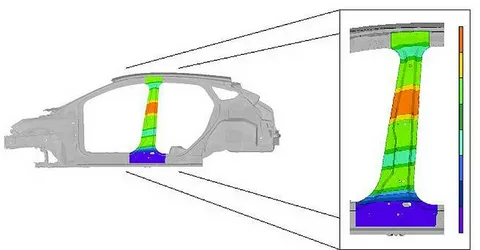The global automotive pillar market is set to witness moderate growth between 2025 and 2035, driven by increasing vehicle production, advancements in automotive safety standards, and the growing adoption of lightweight materials in vehicle structures. The market is projected to reach USD 7,318.6 million in 2025 and expand to USD 9,984.3 million by 2035, reflecting a compound annual growth rate (CAGR) of 3.2% over the forecast period.
Automotive pillars—commonly labeled as A, B, C, and sometimes D—are critical structural components that not only support the vehicle roof but also define occupant safety, visibility, and vehicle aesthetics. As automotive engineering evolves, the automotive pillar market is witnessing a transformation driven by the need for crashworthiness, lightweighting, and sleek design.
From the ultra-strong B-pillar that protects during side impacts to the visually refined A-pillar that frames the driver’s view, pillars are being reengineered to serve a growing list of performance and regulatory demands in the modern mobility landscape.
Get Ahead with Our Report: Request Your Sample Now!
Structural Integrity Meets Lightweight Design
The primary function of automotive pillars is structural. They help maintain the rigidity of the vehicle frame, absorb crash energy, and form the foundation for doors, windshields, and windows. However, as automakers focus on fuel efficiency and electric vehicle range, reducing vehicle weight without compromising safety has become a top priority.
To meet this challenge, manufacturers are using a combination of advanced high-strength steel, aluminum, carbon fiber, and composite materials. These materials allow pillars to be thinner yet stronger—freeing up cabin space and improving visibility without sacrificing structural performance.
Crash Safety and Passenger Protection
Crash safety regulations continue to drive innovation in pillar design. The B-pillar, in particular, plays a vital role in side-impact protection, bearing the brunt of force during collisions. Reinforced with ultra-high-strength steel and integrated with energy-absorbing zones, modern B-pillars are engineered to minimize cabin intrusion and protect passengers.
Additionally, pillars are increasingly designed to accommodate airbag systems, seat belt anchor points, and other safety technologies. Integration of these features into the pillar structure is crucial for improving crash test outcomes and meeting stringent global safety standards.
Enhancing Visibility Without Compromise
While strength is vital, automotive pillars—especially A-pillars—can obstruct driver vision and create blind spots. As a result, design efforts are focused on reducing pillar width without weakening the structure. Engineers are experimenting with novel shapes, thinner profiles, and even transparent or camera-embedded pillars to enhance driver visibility.
Such innovations aim to balance safety and aesthetics while improving situational awareness, particularly in urban and high-traffic environments where split-second visibility can prevent accidents.
Accommodating Advanced Technologies
As vehicles become smarter and more connected, automotive pillars are being reimagined as hosts for sensors, cameras, antennas, and even display screens. In advanced driver assistance systems (ADAS) and autonomous vehicles, pillars may house LIDAR, radar, or infrared sensors, enabling seamless exterior scanning and data collection.
Interior-facing pillar trims are also being redesigned to include touch controls, speakers, ambient lighting, and insulation materials for better acoustics and passenger comfort.
Electric Vehicles and Platform Reconfiguration
The shift to electric vehicles is prompting a reevaluation of vehicle architecture, including pillar placement and integration. With flat floors and modular chassis designs, automakers have more flexibility to optimize pillar geometry for passenger comfort, crash safety, and aesthetic appeal.
Pillars in electric vehicles are often engineered to handle higher torsional loads, especially as roof-mounted battery safety structures or panoramic sunroofs become more common. This necessitates materials and design strategies that go beyond conventional standards.
Exhaustive Market Report: A Complete Study
Manufacturing Complexity and Cost Considerations
Despite their functional simplicity, automotive pillars present manufacturing challenges. The need for precision forming, multi-material joining, and tight tolerances—particularly when integrating safety systems—adds complexity to production processes.
To address this, manufacturers are investing in advanced stamping, laser welding, hot-forming, and composite molding technologies. Cost-efficiency remains crucial, especially in mass-market vehicles, where balancing performance with affordability is a constant concern.
Aesthetic and Design Integration
Automotive pillars play a defining role in vehicle styling. They influence the vehicle’s silhouette, roofline, and window layout—key elements of brand identity and consumer appeal. Designers work closely with engineers to align structural requirements with aesthetic goals, achieving signature designs without compromising function.
From blacked-out pillars that create a “floating roof” effect to hidden seams that emphasize sleekness, pillar treatments are becoming central to exterior design strategies in both luxury and mainstream segments.
Supporting the Next Generation of Mobility
The automotive pillar market is evolving beyond traditional expectations, supporting the shift toward smarter, safer, and more sustainable mobility. These essential components are no longer just metal supports—they are multifunctional elements that house technology, enhance comfort, and enable iconic designs.
As vehicle platforms transform and innovation accelerates, the role of the automotive pillar will continue to expand—supporting not just the structure of the vehicle, but the future of mobility itself.
Catapult Your Strategy: Secure Key Insights with Our Report Checkout!
About Future Market Insights (FMI)
Future Market Insights, Inc. (ESOMAR certified, recipient of the Stevie Award, and a member of the Greater New York Chamber of Commerce) offers profound insights into the driving factors that are boosting demand in the market. FMI stands as the leading global provider of market intelligence, advisory services, consulting, and events for the Packaging, Food and Beverage, Consumer Technology, Healthcare, Industrial, and Chemicals markets. With a vast team of 400 analysts worldwide, FMI provides global, regional, and local expertise on diverse domains and industry trends across more than 110 countries.
Contact Us:
Future Market Insights Inc.
Christiana Corporate, 200 Continental Drive,
Suite 401, Newark, Delaware – 19713, USA
T: +1-845-579-5705
For Sales Enquiries: sales@futuremarketinsights.com
Website: https://www.futuremarketinsights.com
LinkedIn| Twitter| Blogs | YouTube


